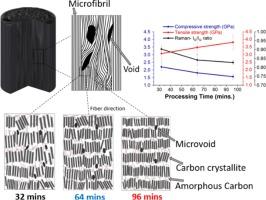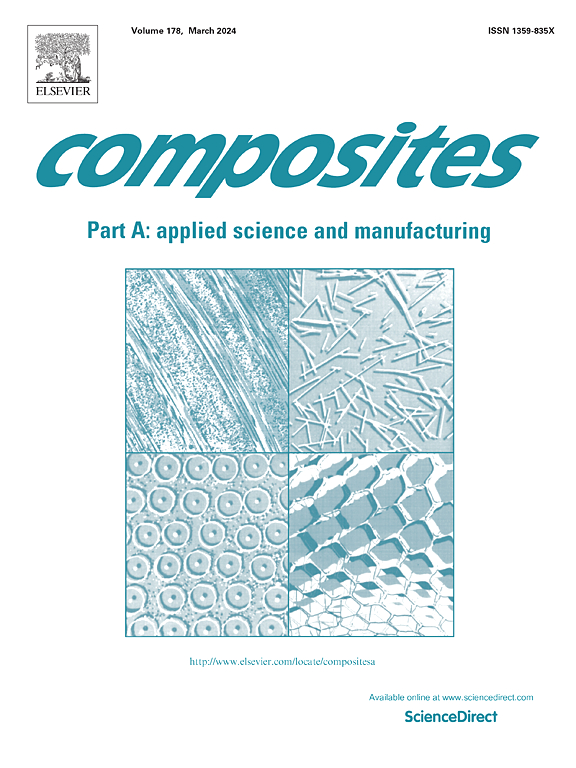利用较高的湿纺盘状纤维稳定率了解微观结构对碳纤维拉伸和压缩性能的影响
IF 8.1
2区 材料科学
Q1 ENGINEERING, MANUFACTURING
Composites Part A: Applied Science and Manufacturing
Pub Date : 2024-10-14
DOI:10.1016/j.compositesa.2024.108524
引用次数: 0
摘要
本研究介绍了在碳纤维生产过程中,利用不同的稳定时间将聚丙烯腈(PAN)原纤维转化为碳纤维的过程。湿纺原丝纤维是一种专门设计的 PAN 共聚物,由丙烯腈、丙烯酸甲酯和 3 wt% 的衣康酸组成。在氧化炉中的停留或稳定时间分别为 32、64 和 96 分钟,从而能够研究微观结构对拉伸和压缩性能的影响。利用连续中试规模的碳化生产线加快环化和脱氢,前驱体纤维表现出较低的摄氧量,有助于形成密度更低、更无定形的碳纤维。基于同步加速器的 SAXS-WAXS 表征和碳纤维微观结构的拉曼光谱显示了较低的取向度和结晶度,以及较高的空隙浓度。这导致导电率降低,拉伸强度降低(19%),但当稳定时间从 96 分钟缩短到 32 分钟时,抗压强度提高(27%)。本文章由计算机程序翻译,如有差异,请以英文原文为准。

Using higher rates of stabilization of a wet-spun pan fibre to understand the effect of microstructure on the tensile and compressive properties of carbon fibre
The transformation of a polyacrylonitrile (PAN) precursor fibre into carbon fibre using varying stabilization times during carbon fibre manufacture is presented in this work. The wet-spun precursor fibre is a specifically designed PAN co-polymer made up of acrylonitrile, methyl acrylate and 3 wt% itaconic acid. The residence or stabilization times in the oxidation ovens are varied from 32, 64 and 96 min, enabling investigation of the impact upon microstructure upon tensile and compressive properties. Using a continuous pilot scale carbonization line for faster cyclization and dehydrogenation, the precursor fibres exhibited lower oxygen uptake contributing to the formation of a less dense and more amorphous carbon fibre. Synchrotron based SAXS-WAXS characterisation and Raman spectroscopy of the carbon fibre microstructure displays lower orientation and crystallinity, with higher void concentration. This led to lower electrical conductivity, lower tensile strength (19 %) but higher compressive strength (27 %) when reducing stabilisation times from 96 to 32 min.
求助全文
通过发布文献求助,成功后即可免费获取论文全文。
去求助
来源期刊

Composites Part A: Applied Science and Manufacturing
工程技术-材料科学:复合
CiteScore
15.20
自引率
5.70%
发文量
492
审稿时长
30 days
期刊介绍:
Composites Part A: Applied Science and Manufacturing is a comprehensive journal that publishes original research papers, review articles, case studies, short communications, and letters covering various aspects of composite materials science and technology. This includes fibrous and particulate reinforcements in polymeric, metallic, and ceramic matrices, as well as 'natural' composites like wood and biological materials. The journal addresses topics such as properties, design, and manufacture of reinforcing fibers and particles, novel architectures and concepts, multifunctional composites, advancements in fabrication and processing, manufacturing science, process modeling, experimental mechanics, microstructural characterization, interfaces, prediction and measurement of mechanical, physical, and chemical behavior, and performance in service. Additionally, articles on economic and commercial aspects, design, and case studies are welcomed. All submissions undergo rigorous peer review to ensure they contribute significantly and innovatively, maintaining high standards for content and presentation. The editorial team aims to expedite the review process for prompt publication.
 求助内容:
求助内容: 应助结果提醒方式:
应助结果提醒方式:


